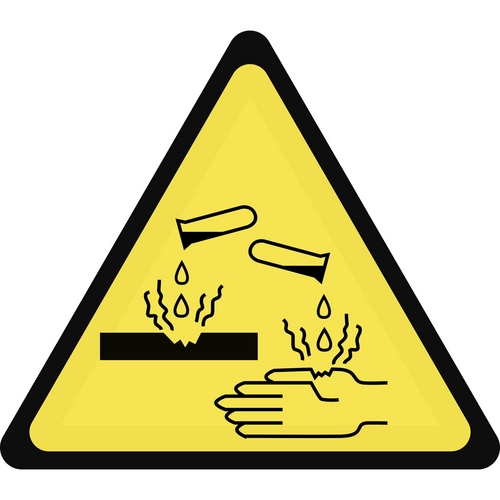In yesterday’s Advisor, we gave background information and instructions for corrosives training. Today, we provide best practices and emergency first-aid training instructions.
 |
To recap: The Occupational Safety and Health Administration’s (OSHA) Hazard Communication Standard requires you to train employees to work safely with the hazardous chemicals in their work area when they’re initially assigned to that area and when a new hazard is introduced. Workers can be trained in categories of hazardous chemicals, such as corrosives.
Workers may know that corrosive chemicals pose a danger to their skin, but they may be less aware that these chemicals pose a threat of internal damage or of reactivity. So train them on the following best practices and emergency first aid.
Best Practices
Use these safe work practices to protect yourself from corrosives:
- Always check both the label and the SDS to learn the hazards of the chemical you are using.
- Label corrosive chemicals with care. Because many are innocent-looking clear liquids, the label is vital to proper identification.
- Store corrosives properly. Acids and alkalis should be stored separately, because they can react violently with one another. Make it obvious from the way they’re stored that they are not for human consumption—acids and caustics stored in sports-drink bottles, for example, are an invitation for accidental ingestion.
- Move containers of corrosives with care.
- Use ventilation to reduce airborne exposures.
What is the most effective and cost-efficient way to provide safety training for your workforce? Try a demo of BLR’s remarkable TrainingToday® at no cost or obligation.
Also, wear protective clothing when you work with corrosives:
- Wear chemical-resistant safety goggles to protect your eyes from splashing or spraying liquids and corrosive mists.
- Wear protective gloves if you will be handling corrosive liquids.
- Wear aprons, safety shoes, and face shields if you may encounter splashing or spraying corrosive liquids.
Emergency first aid
React quickly if you come in contact with a corrosive chemical:
- If a corrosive chemical gets in your eyes, immediately flush your eyes with water for at least 15 minutes. Seek prompt medical treatment, especially for alkali exposures.
- If a corrosive gets on your skin or contacts your mucous membranes, immediately flush affected skin under a safety drench shower, and remove any clothing beneath the level of contact.
- If you swallow a corrosive chemical, do not induce vomiting. You could do additional damage to your esophagus, throat, and mouth. Drink water to dilute the chemical, and immediately seek medical treatment.
Practice tip
Make sure workers know where their nearest eyewash and safety drench shower are—and how to activate them.
Try a demo of BLR’s remarkable award-winning TrainingToday® at no cost or obligation. This includes the Workplace Safety Library. Get the details.
Conclusion
Corrosives pose multiple hazards to workers. Workers must follow safe work practices, wear protective equipment, and know how to react to exposure situations when working with corrosive chemicals.
